You may not find this terribly rewarding unless you're included here, so this is a good time for casual and random browsers to turn back before they get too caught up in the sweep and majesty of the proceedings and can't let go.
The plan is to luxuriate for twelve days in Viterbo, with enthusiastic sight-seeing in the region, and a few days tacked onto either side of that for getting there and back.
Viterbo and the "Christmas Village"

3 December 2017, it's time for another exploration around Viterbo, on the first full day of the city's first "Christmas Village", a hopefully-annual Christmas season market-cum-amusement park. Behind Kristin in the Piazza Scacciaricci, up the alley from our flat, is Le Poste dei Bambini, where you can park your little ones whilst you wander about and shop.
The stairway is a good example of the distinctive Viterbese profferlo, an external staircase to the main entrance on the first floor with a balcony protecting the space beneath, usually a shop front or workshop.

Elves, a small army of teens of both genders kitted out to help the merrymakers enjoy the event

A good elf photo by Juan Carlos
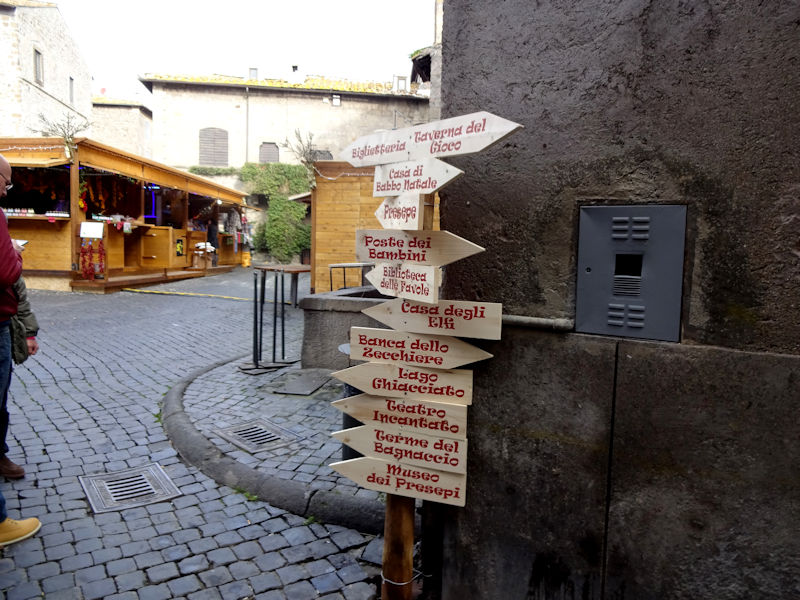
Orienting ourselves in the Piazza San Carluccio

The Chiesa di Santa Maria Nuova in the Via Bacciadone

The church was known in some form as early as 1080, when it was donated to the city and served as an archive and civic meeting hall until the Palazzo dei Priori assumed those functions. Tradition says that Thomas Aquinas preached here in 1266.

A very attractive church with a nave and two aisles, with six columns on each site, each column with its own capital.

John the Baptist, St Jerome, and Lawrence, by Antonio del Massaro da Viterbo, ca. 1504

Kristin lighting a candle for a friend
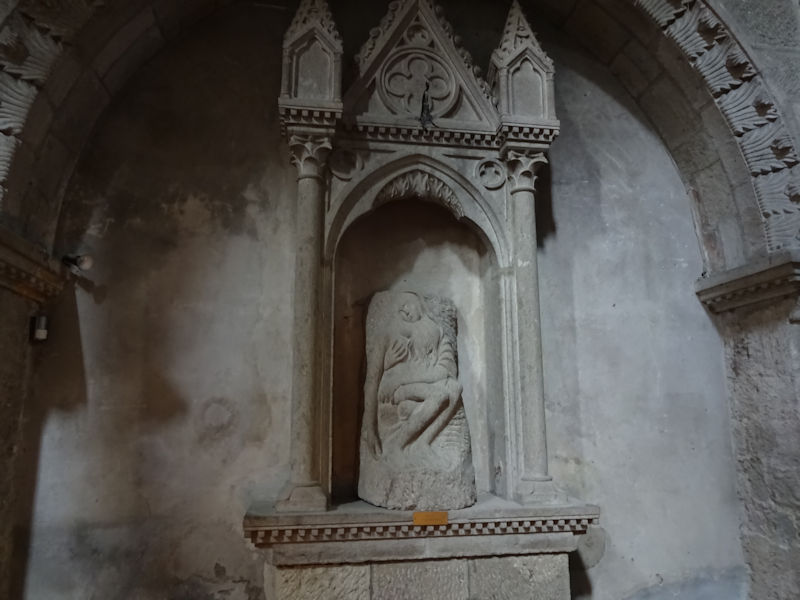

Another candle for the same friend


Jesus and his full-size friends, and a pint-size donor

A very fine church -- it escaped the 1944 bombing very well, by the looks of it.

Along the Via Cavour
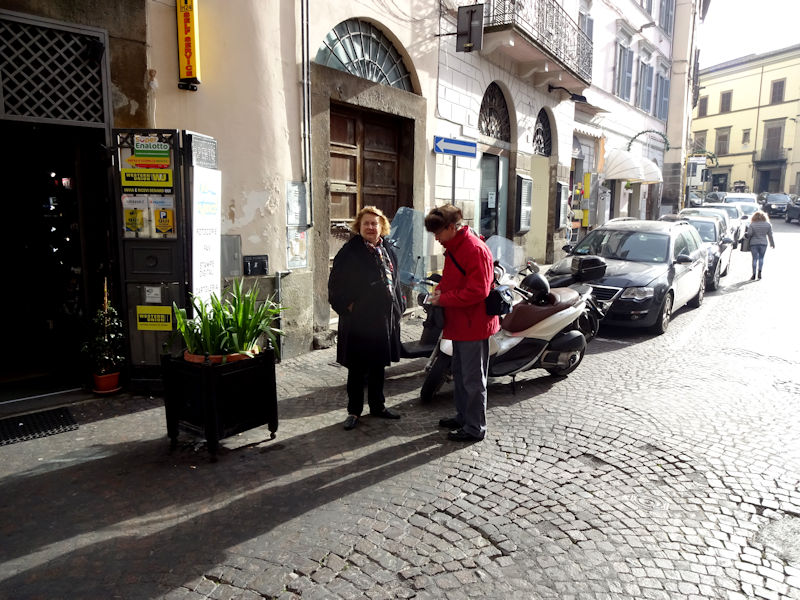
In the Piazza Fontana Grande; I'm told that we are looking for a stationery shop that sells fine writing paper.
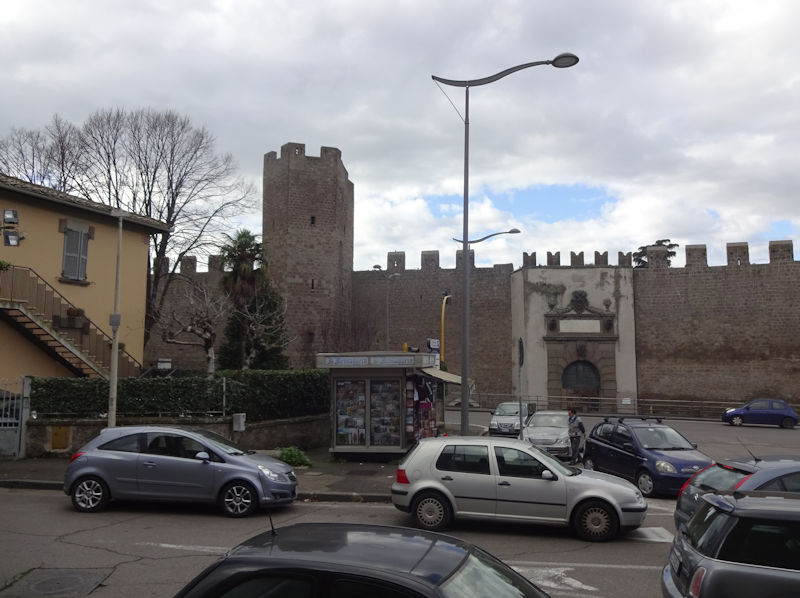
We're out the Porta della Verità and across the road, about to visit the Civic Museum of Viterbo and . . .
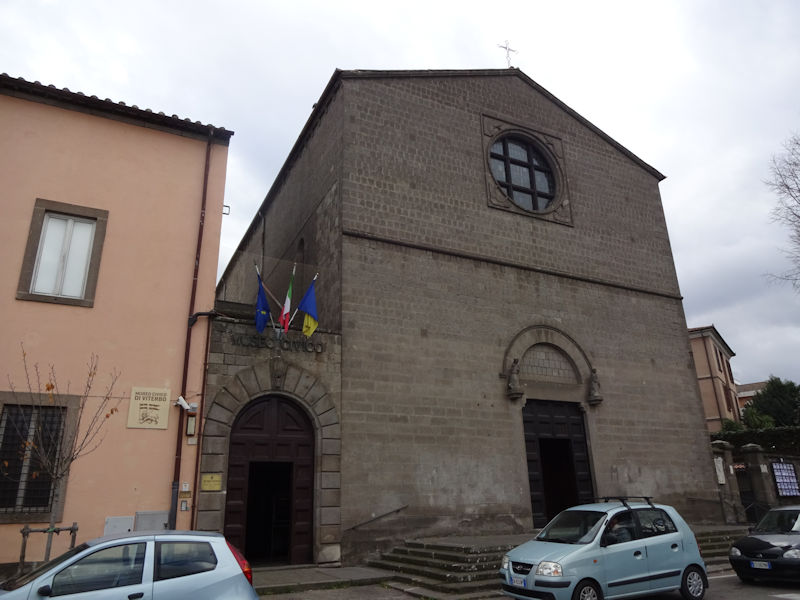
. . . the adjacent church of Santa Maria della Verità, founded by the Premonstratensian order of regular canons in the 12th century and renovated in the 14th century by the mendicant order of the Servants of Mary.
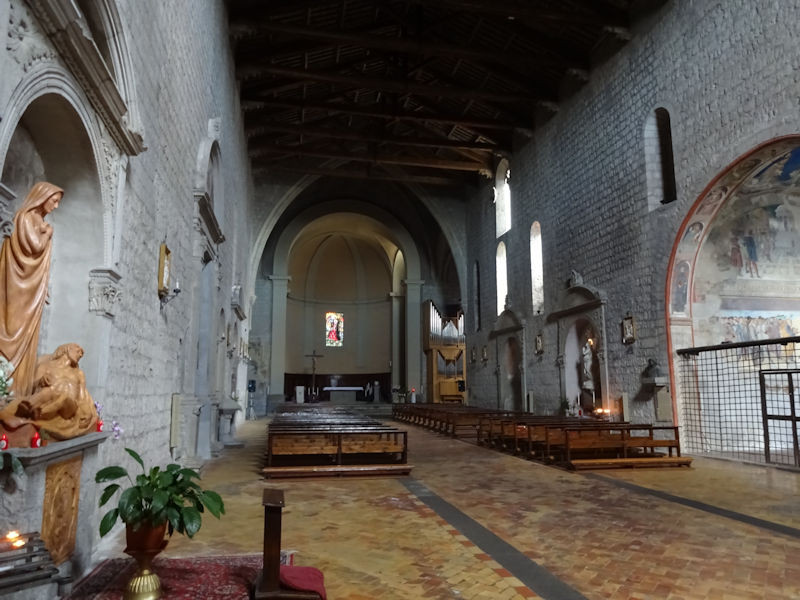
Inside the Parrocchia Santa Maria della Verità

A low-budget confessional
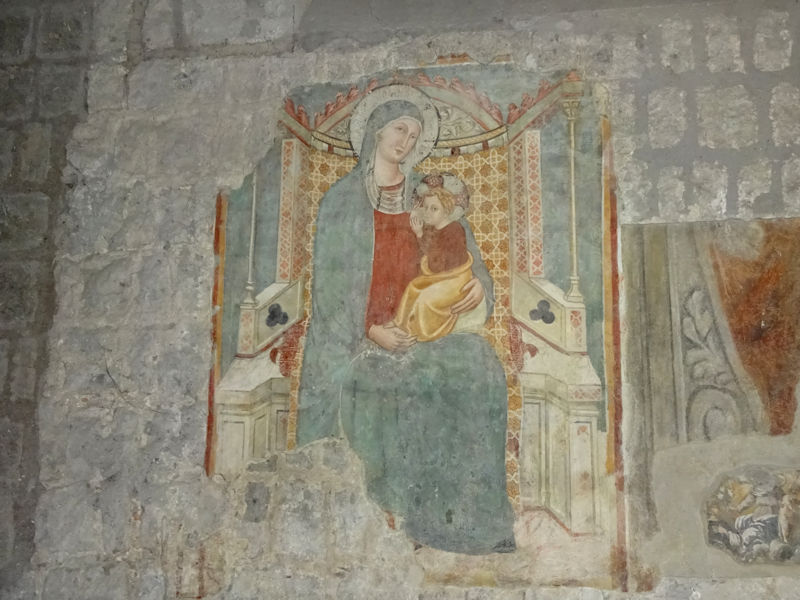
A nursing Madonna
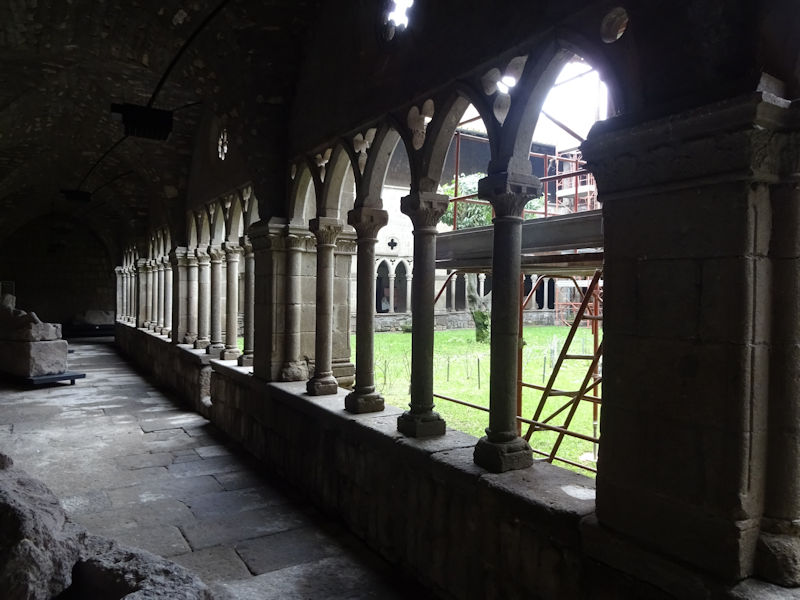
The Civic Museum has been housed since 1955 in the convent and cloisters adjacent to the church -- it specializes on the ground floor in Etruscan and Roman archaeological artifacts, and medieval and modern stuff up the stairs.

(photo by Juan Carlos)

Nobody ever did sarcophagi like the Etruscans. They always look like they're having a luxurious dinner and an amiable chat with their spouses.

A parade of sarcophagi
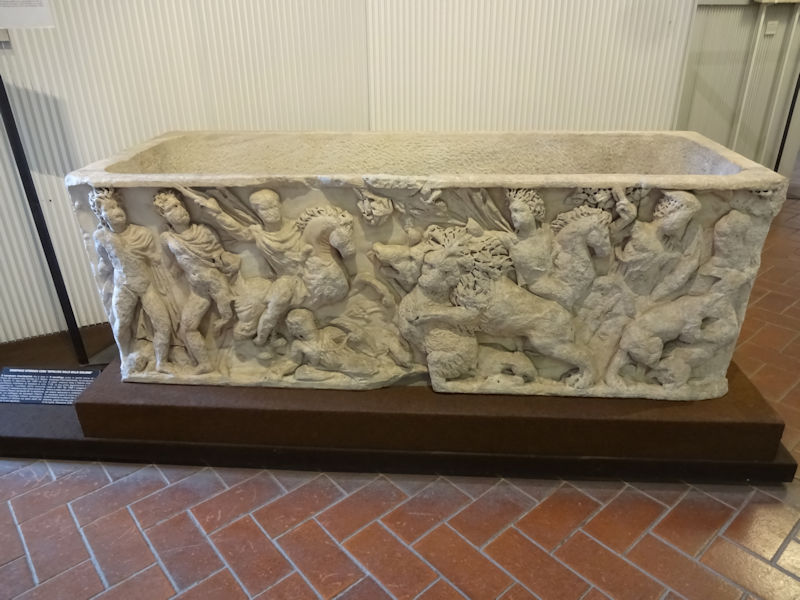
The wild boar-hunting sarcophagus, a modern copy of which by L. Funari we saw on the Church of St. Angelo in Spatha on our first day here.
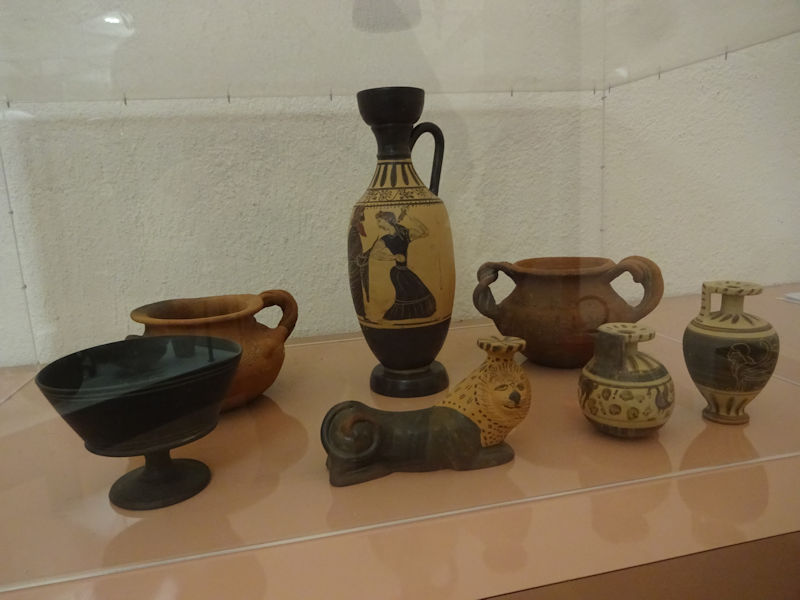
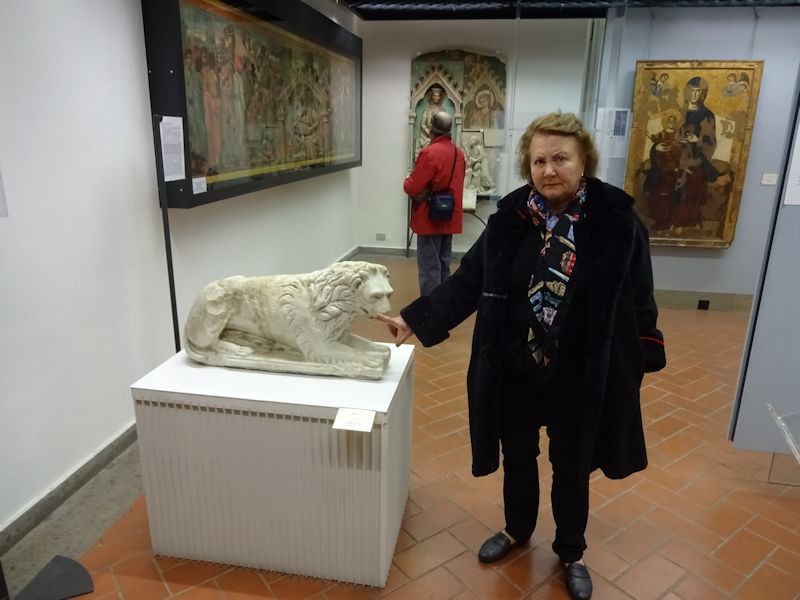
I usually insist upon adding to our growing collection of Kristin's hand in the lion's mouth.
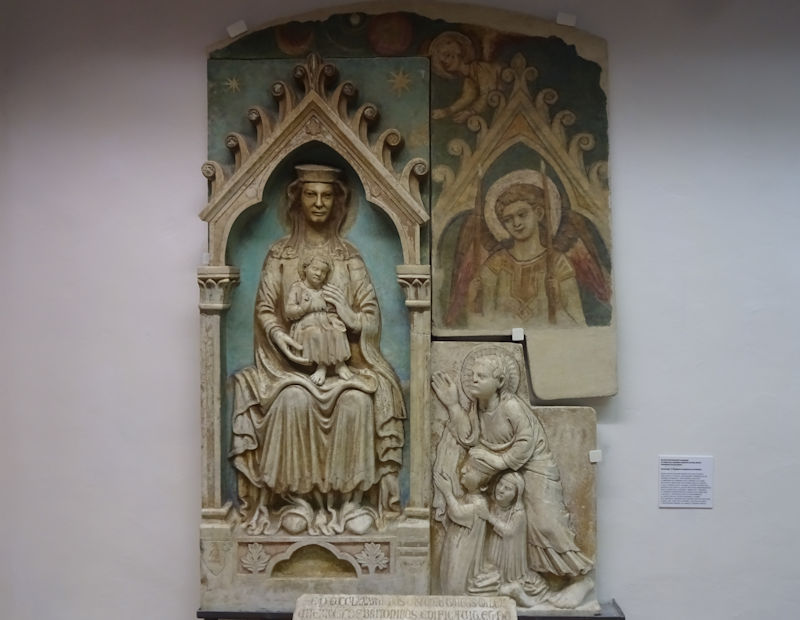
The Stern Madonna (14th century)
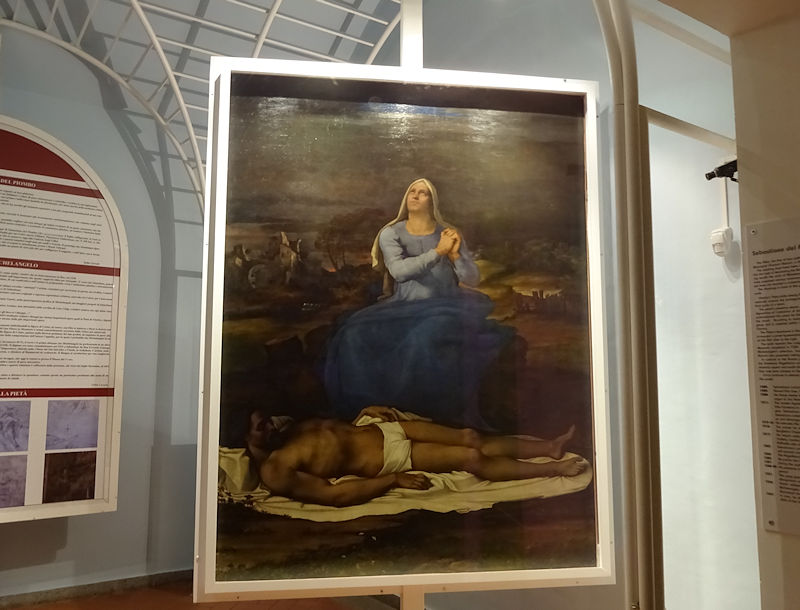
A surprising Pieta, one of two early works in Viterbo by Sebastiano del Piombo in 1516, praise for which launched him on his 30-year career with Medici and papal patrons
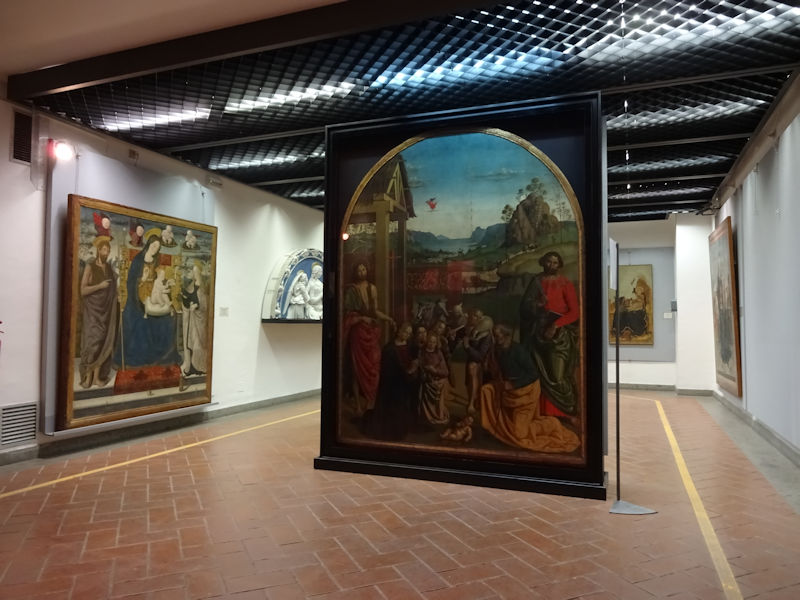
A huge picture of shepherds visiting Baby Jesus by Antonio del Massaro ('Il Pastura') of Viterbo, about 1488 . . .
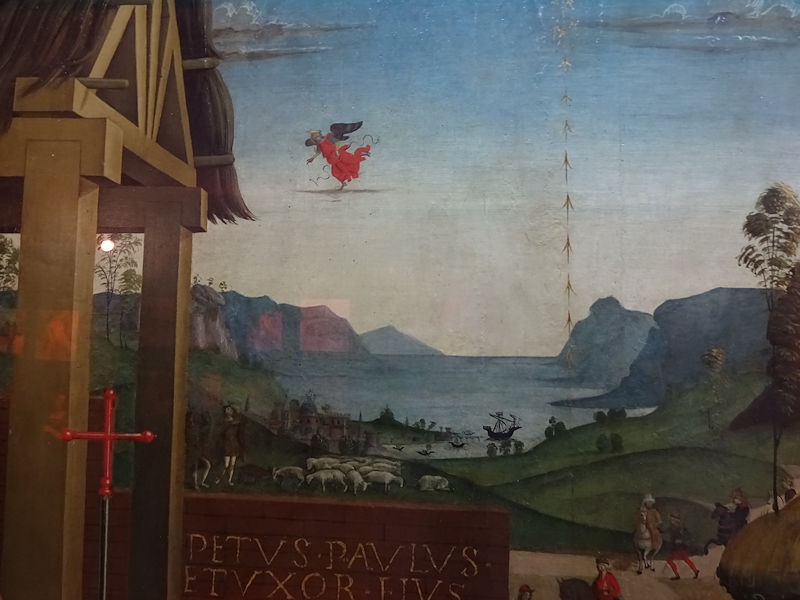
. . . with an odd creature sailing by in the sky.

Baby Jesus conveying the Mystic Marriage ring on St Catherine (presumably Catherine of Alexandria) by Pancrazio di Antonello da Calvi in about 1477, with horrific little creatures hovering about overhead.
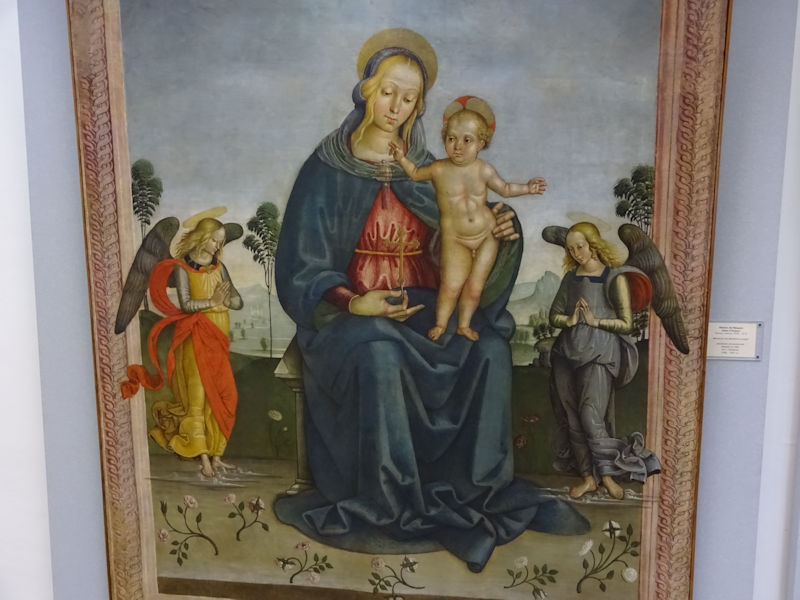
Another by Antonio del Massaro ('Il Pastura') of Viterbo, between 1492 and 1497, with wings, etc., overflowing the apparent frame
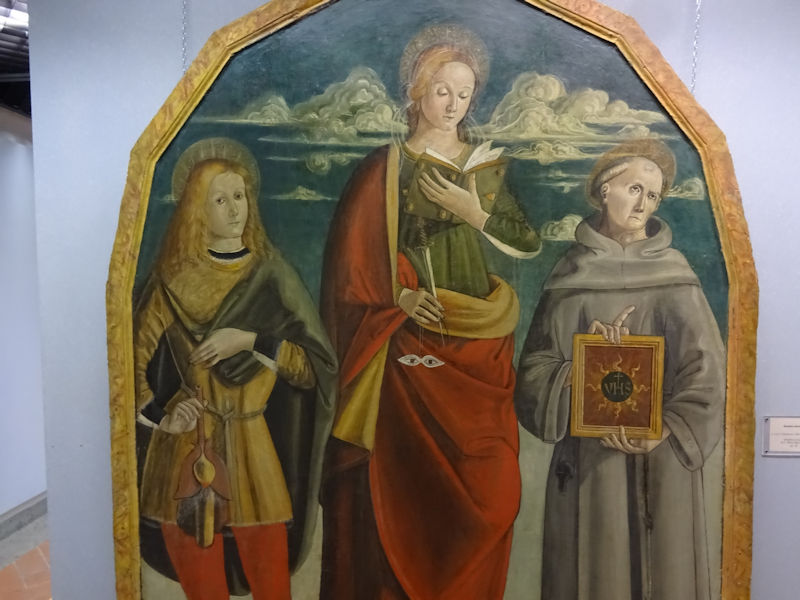
By an anonymous Viterbese in the 15th century. St Lucia of Syracuse, one of the most popular medieval saints and the patron of the blind, supposedly died in the Diocletian persecution of AD 304 and is usually portrayed holding her eyes on a plate, and often holding a dagger. St Ansanus ("the Apostle of Siena"), preacher of the Gospel around Bagnoregio, survived Diocletian torture and was then taken to Siena where he made many converts and was beheaded in AD 304; now one of the two patron saints of Siena, he's often shown dressed as a warrior and holding dates or a fig. St Bernardino of Siena was a famous Franciscan preacher and economist and a popular crusader against sodomy, witchcraft, immodest clothing, Jews, and infanticide, and was canonized just six years after his death in 1444; he's usually shown holding the IHS on a disc in a circle of flames.
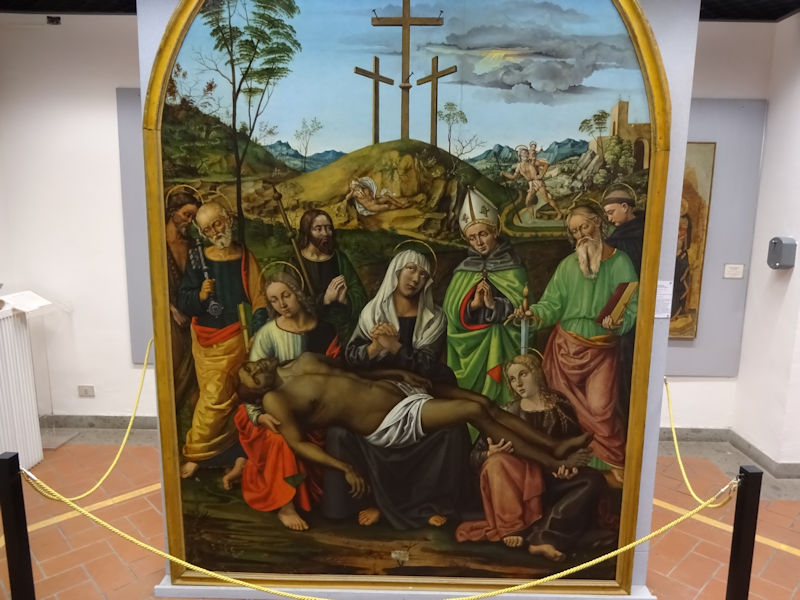
A Deposition of Christ with a lot of people who don't seem terribly upset about it; commissioned from Costantino di Jacopo Zelli in 1517 for the altar of this very church.
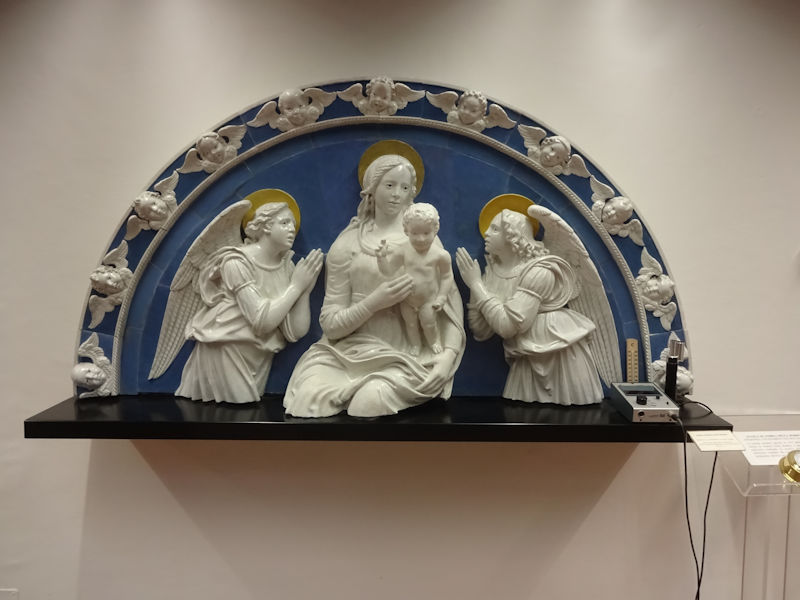
A lunette attributed to the Scuola di Andrea della Robbia, about 1515
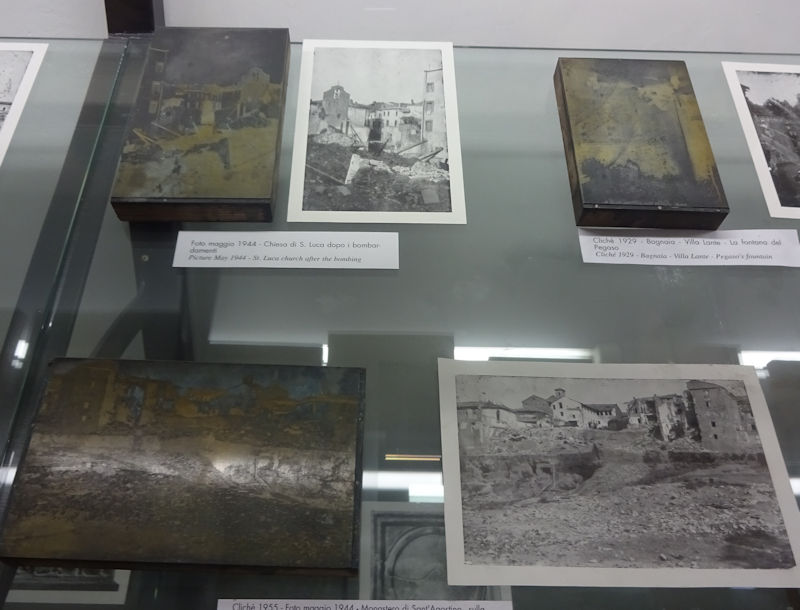
A collection of photographs of Viterbo after Allied bombers had finished with it in May 1944
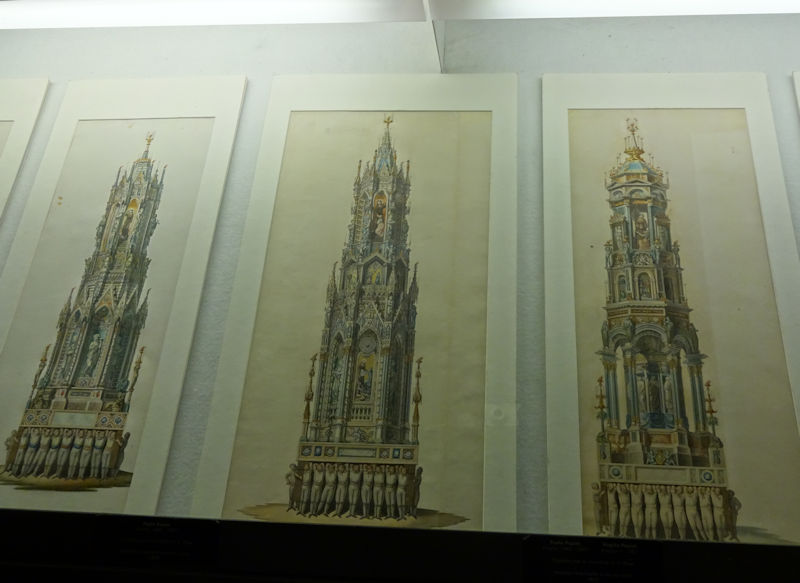
A collection of paintings of the Macchina di Santa Rosa over time, carried in procession by 100 men called the Facchini every 3 September

Leaving the Civic Museum and reentering the old city by the Porta della Verità, this is another good example of a profferlo external staircase.
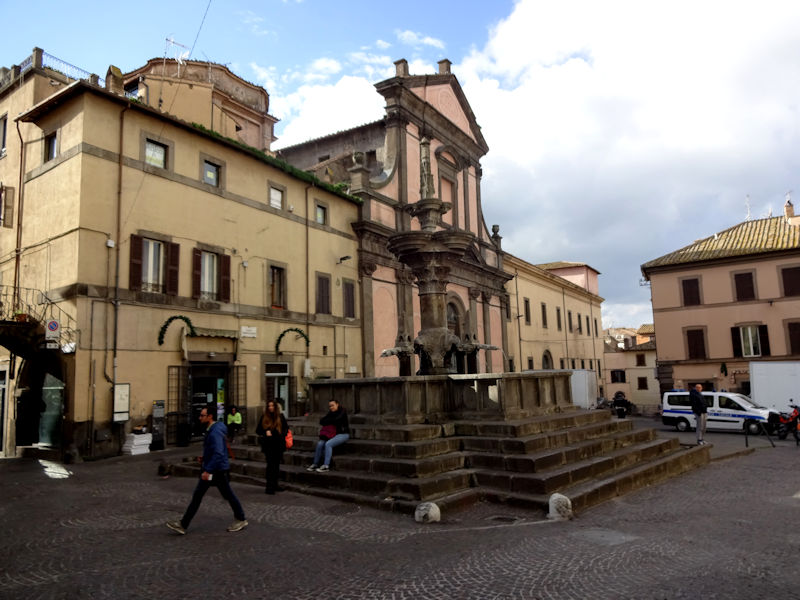
The Fontana Grande again

The Piazza del Plebiscito again, getting ready for Christmas
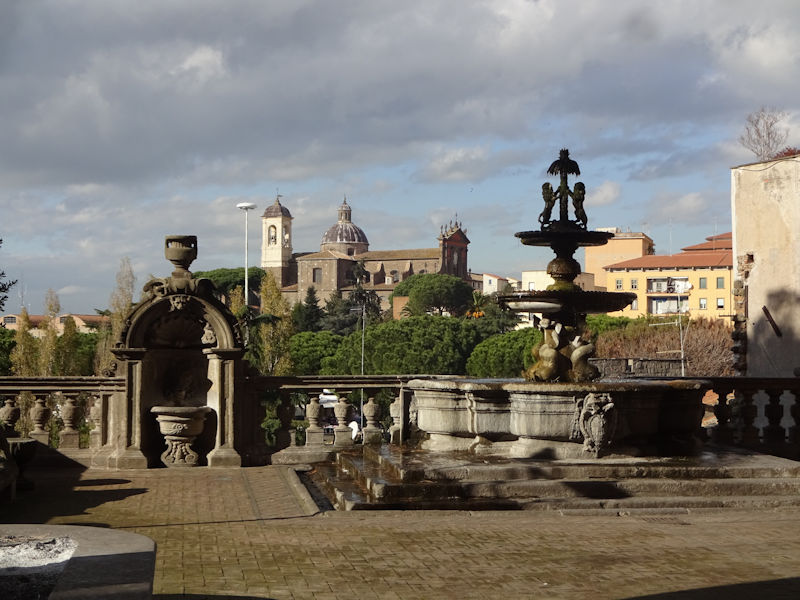
The church of Santa Maria della Trinità across the parking lots in the valley below, seen from the balcony behind the Palazzo dei Priori or City Hall. The Palazzo has always been closed up when we've come by, but we've noticed an unguarded door that might solve our problem.
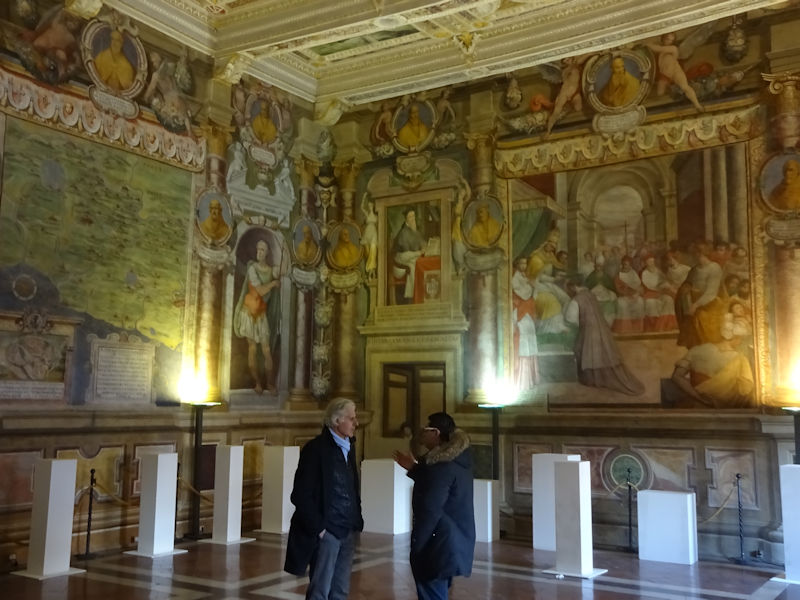
Uh oh, just council rooms in this part of the building (the pinacoteca is apparently at the far end of the complex). But this is interesting, too.
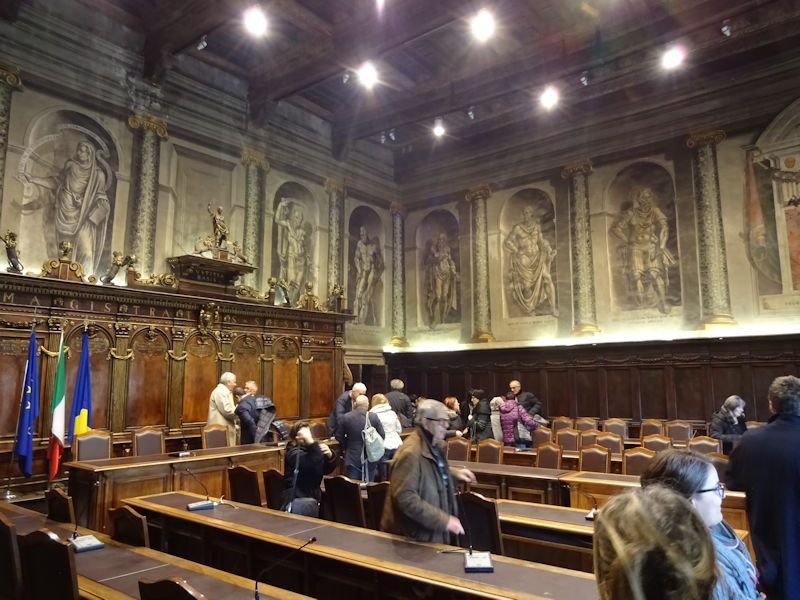
The Council meeting is breaking up. The old adage says that when you're in a place you don't belong, keep moving fast and look like you do belong.
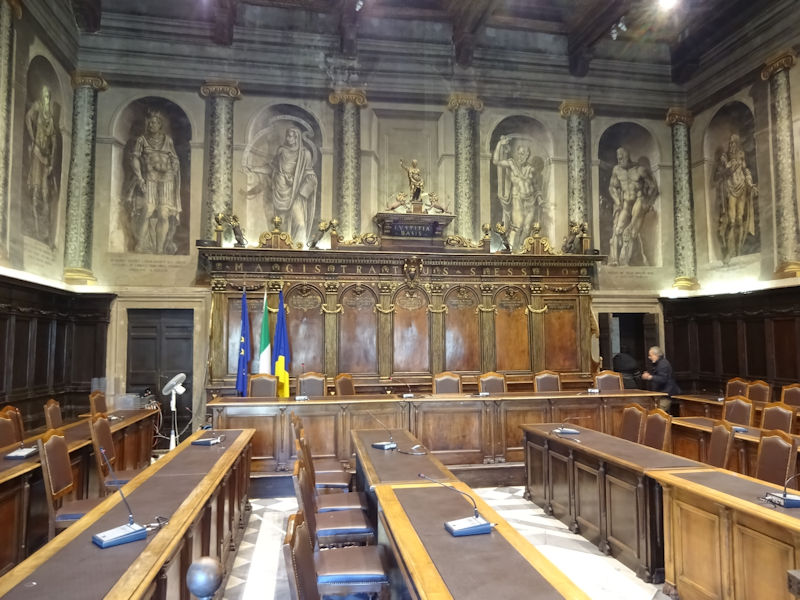
The Council chamber
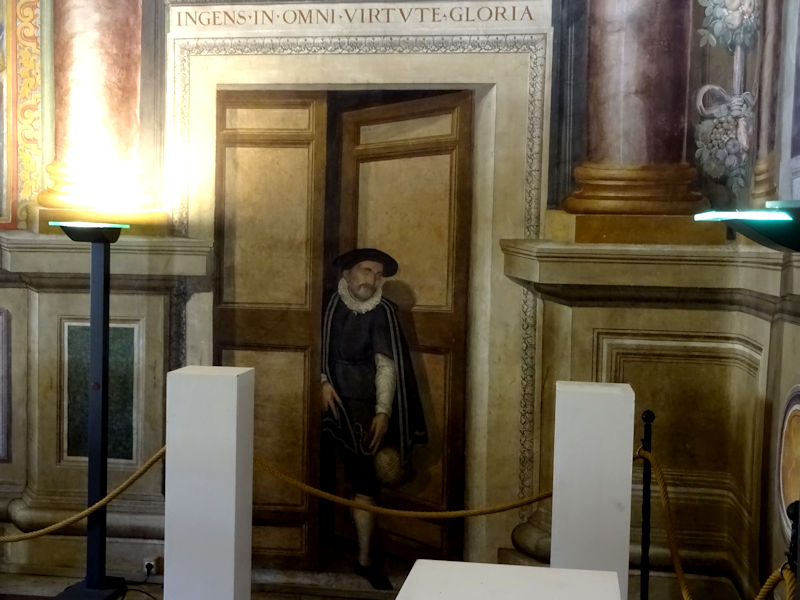
Yikes, we're busted.
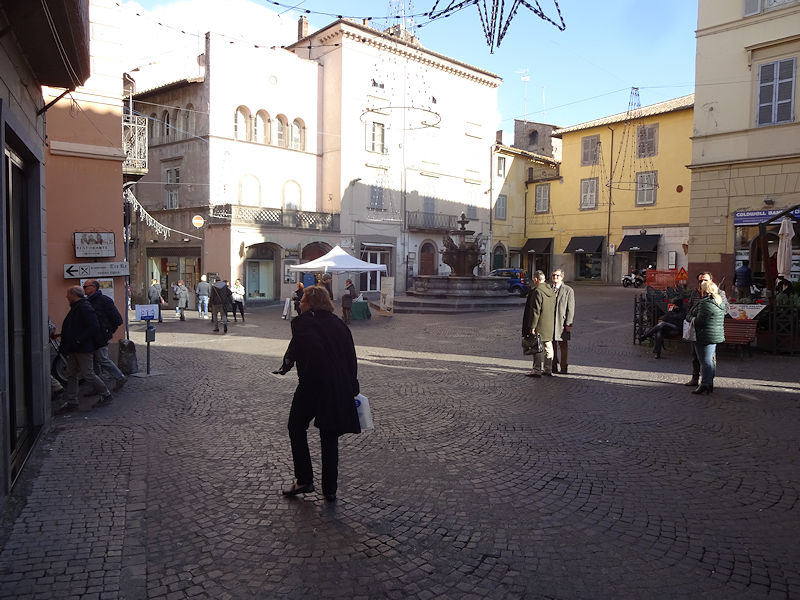
Escaped from the Palazzo, we're in the Piazza delle Erbe to make a dinner reservation (which we will later have to break).
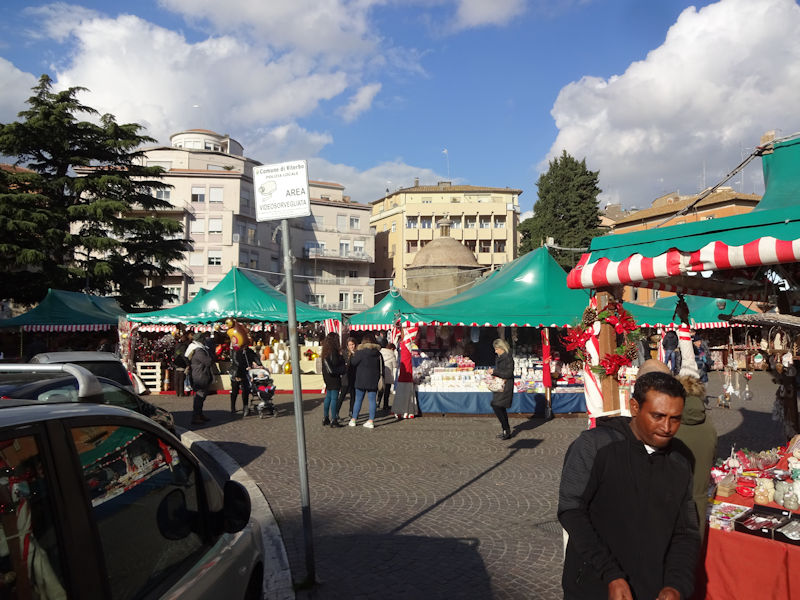
Down the hill to the parking lots of the Parcheggio del Sacrario in the Piazza Martiri d'Ungheria for the Saturday markets

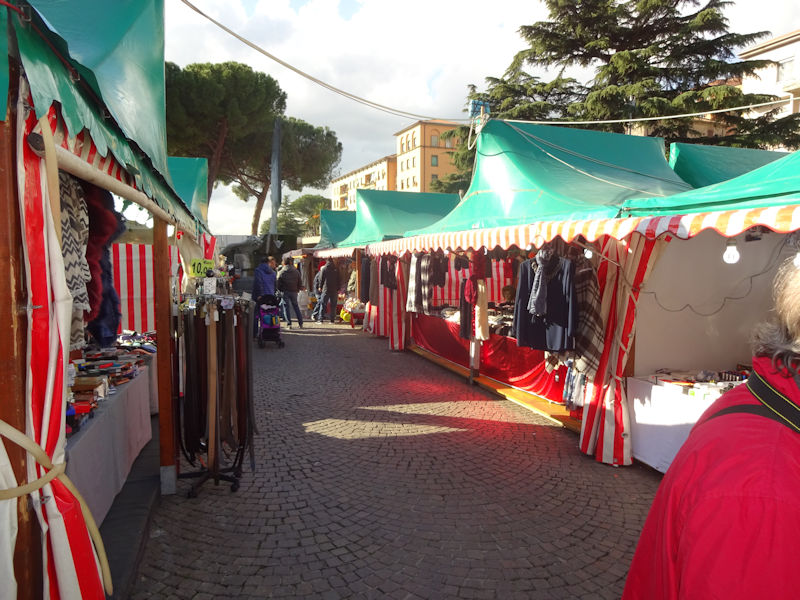
Colorful market

The little temple of Santa Maria delle Peste, erected in 1494 in thanks for having been saved from the plague.

Now straight north up the hill on the Via Cairoli to the Piazza di San Faustino and its fountain of the same name from 1251.

The Romanesque Church of San Faustino, built before 1226 and expanded in the 15th century with chapels added by noble families. When the Order of the Knights of Jerusalem were thrown off the island of Rhodes by the Ottomans in 1523, they were allowed to reside temporarily in the nearby Rocca Albornoz and worship in this church; thus their relics were transferred here and over the next three years several knights were buried in the church. In 1527 they left here and reluctantly accepted the island of Malta in 1531, moved there and thereafter became the Knights of Malta (which recently unwisely tangled with Pope Francis over condoms). [D. Seward, The monks of war, 1995] The church was largely revised and updated in 1759, though the bell tower was last altered in the 16th century.
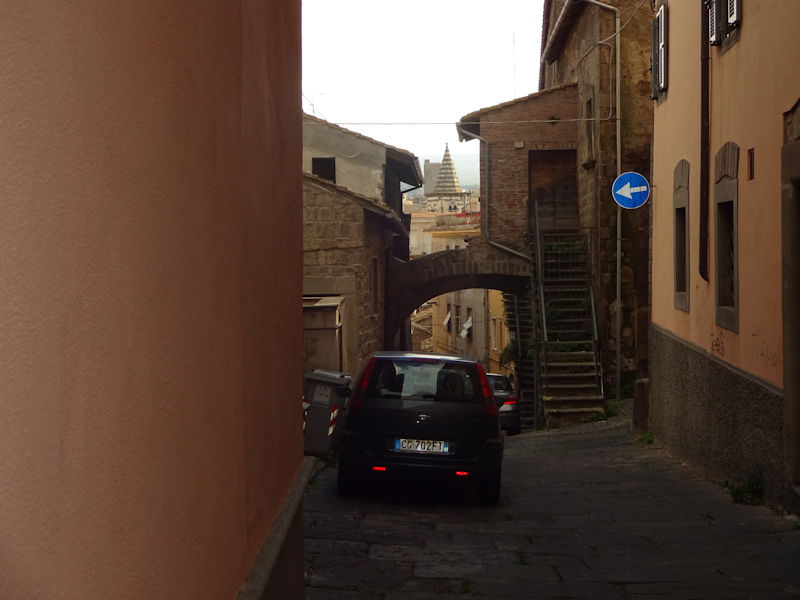
A glance downtown at the Chiesa di San Giovanni Battista
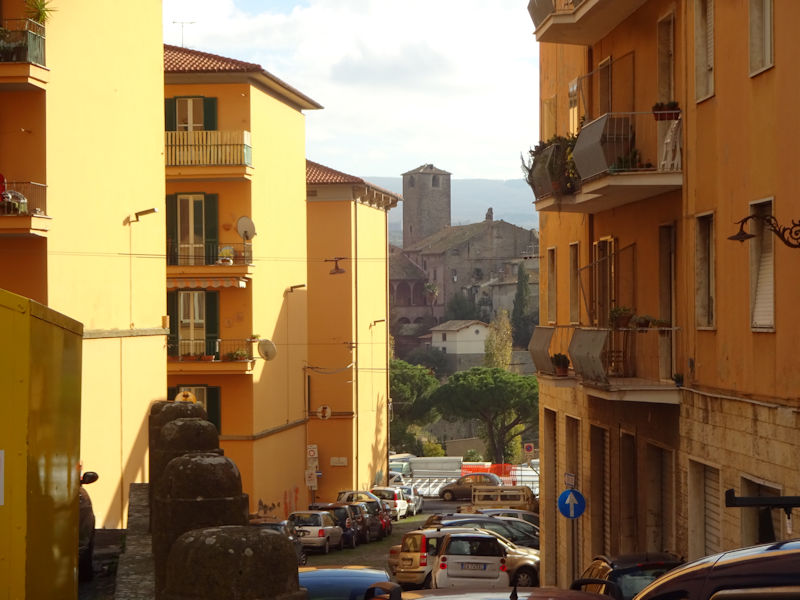
Another glance downtown at the Chigi Palace

The Chiesa di Santissima Trinità was built on this high point in the old city by the Augustinian Fathers in 1256, but thoroughly revised in the mid-18th century.
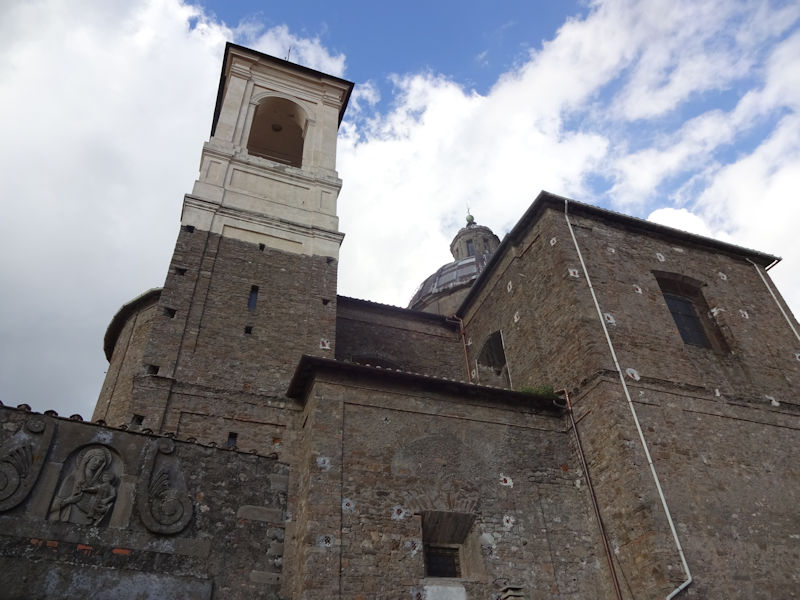
We've been staring at this thing from the other high points in the city, by the Piazza del Plebiscito and the Papal Palace, yearning to see it up close, and it's quite a disappointment.
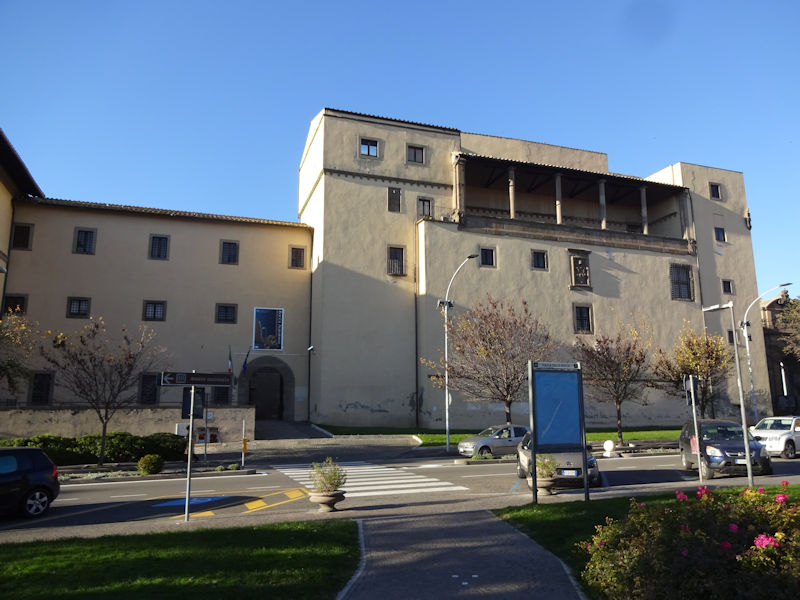
Just down the street, near the Porta Fiorentina, this is the Rocca Albornoz, built in 1354 by the Papal military commander Cardinal Albornoz who brought the traditional territories of the papacy, then residing in France, back into the holy obedience. It's also the home of the Museo Nazionale Etrusco.
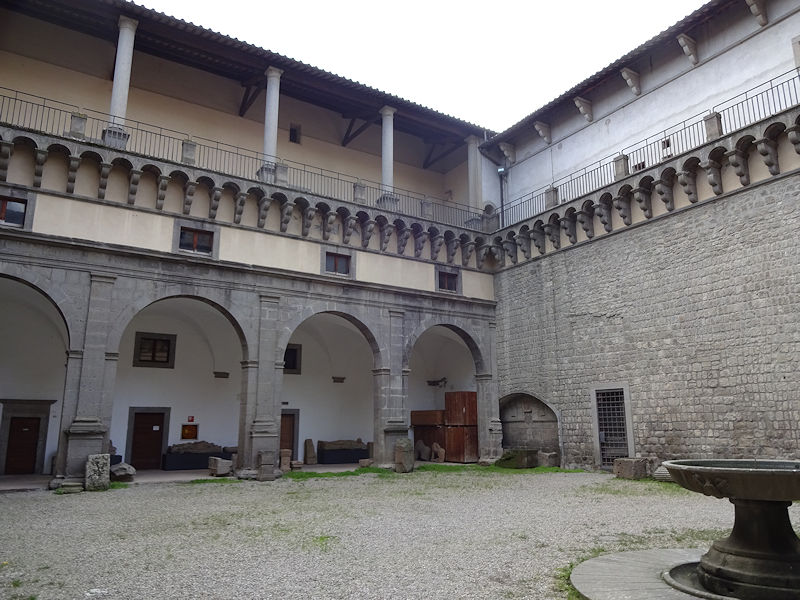
The courtyard and stables, and perhaps much else, were re-designed by Bramante, on loan from Pope Julius II in 1504-1506.


It's a very well designed exhibition of Etruscan artifacts, spacious, and with good explanations.
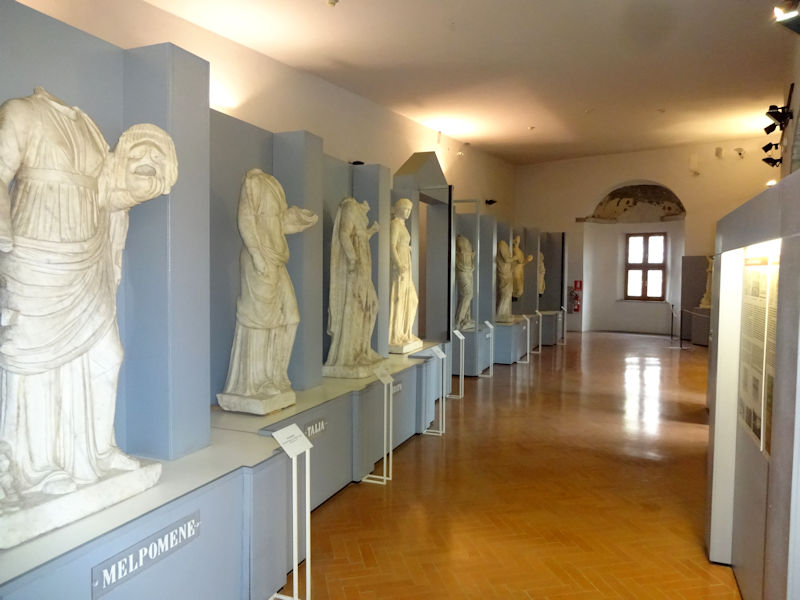

The Fontana di Piazza della Rocca from the balcony or loggia at the front of the fortress
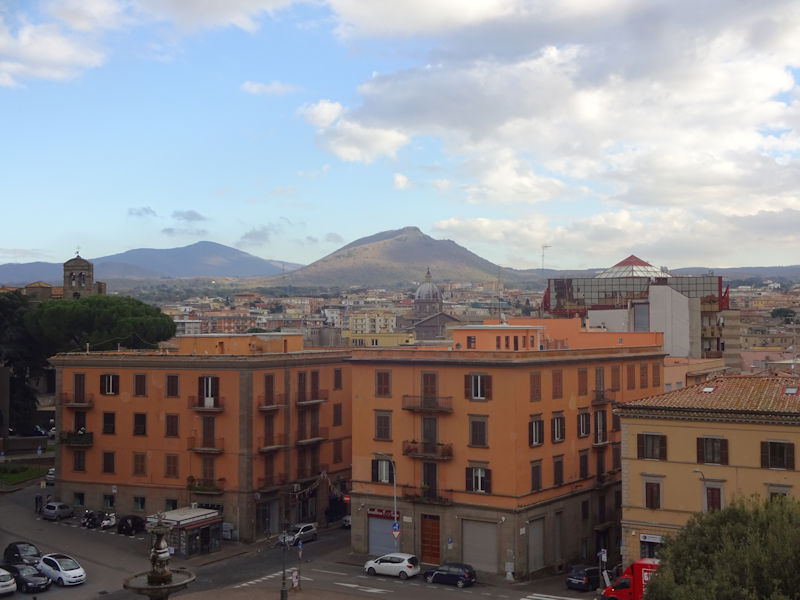
The surrounding countryside to the south

This is a small cult sanctuary recovered from a cave in 2006, containing two terracotta statues of Demeter/Vei/Cerere, seated, and her daughter Persephone/Prosperine emerging from the underworld, with a small altar for making upside-down offerings. It's dated to the late 3rd or early 2nd century BC.

Back out on the street again
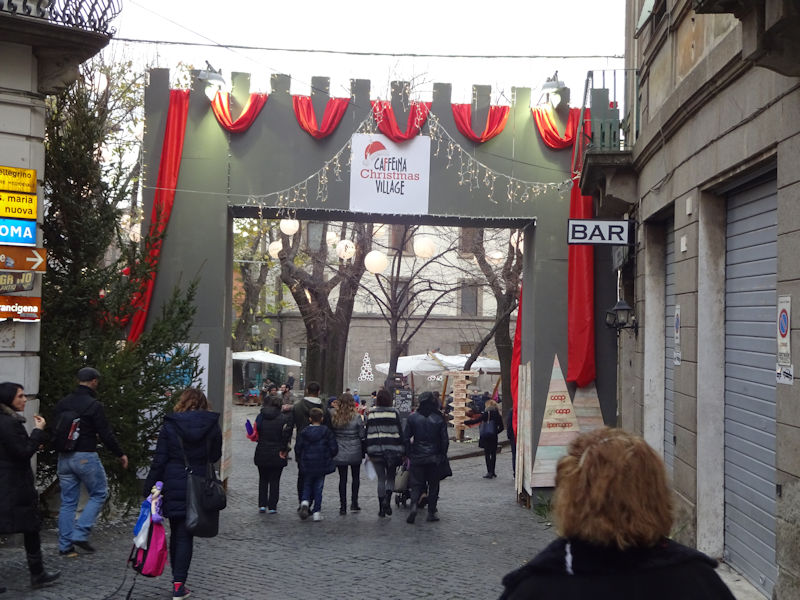
Entering the Christmas Village through the "castle gate" (which we saw them tacking up last night) into the Piazza delle Morte. The Fondazione Caffeina Cultura is a Viterbo not-for-profit set up in 2012 to develop cultural events in the city, and we were told that this is the first year for its Christmas Village extravaganza.

Lots to see -- we need to get going.

The line's too long for us at the House of Elves, and we might not even fit into it.

For some reason, after each small group of excited kids and their forbearing parents emerge, smoke comes out the door.

In the Palazzo Farnese, this is presently serving as the Library of Fables (Biblioteca delle Favole), with books evidently.

The Lago Ghiacciato or Lake of Ice, which is actually some sort of plastic surface
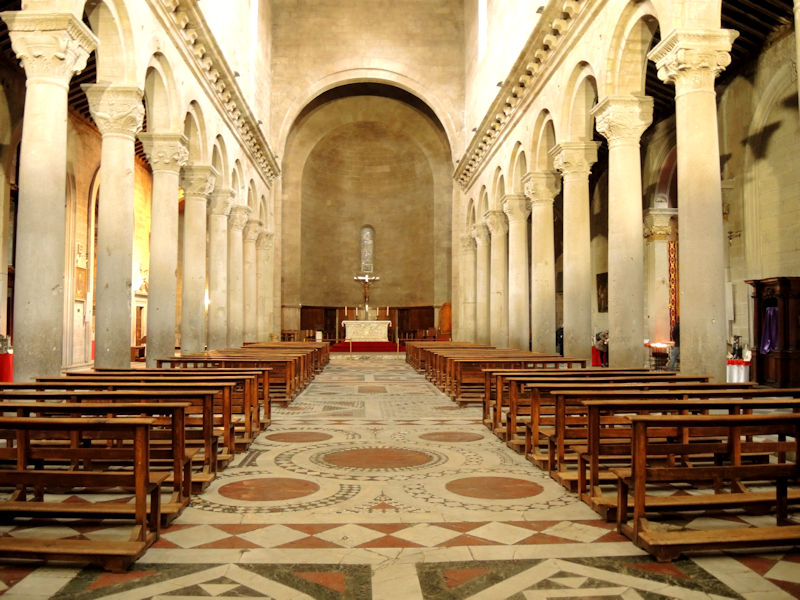
Into the Duomo, to see the "scenari in miniatura" (photo by Juan Carlos)
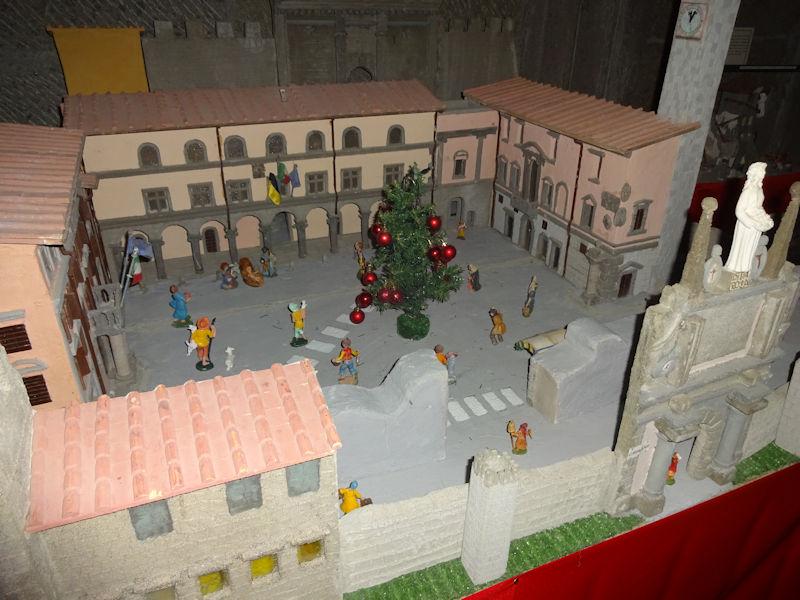
Throughout the interior of the Cathedral, these are a number of miniature urban constructions by the master Giulio Bernabucci; I've selected only those most relevant to our visit. This is the Piazza del Plebiscito with the city hall.

This is our neighborhood, the Piazza San Pellegrini and, on the left, the Piazza Scacciaricci (if I understood correctly, this is all papier-mâché).
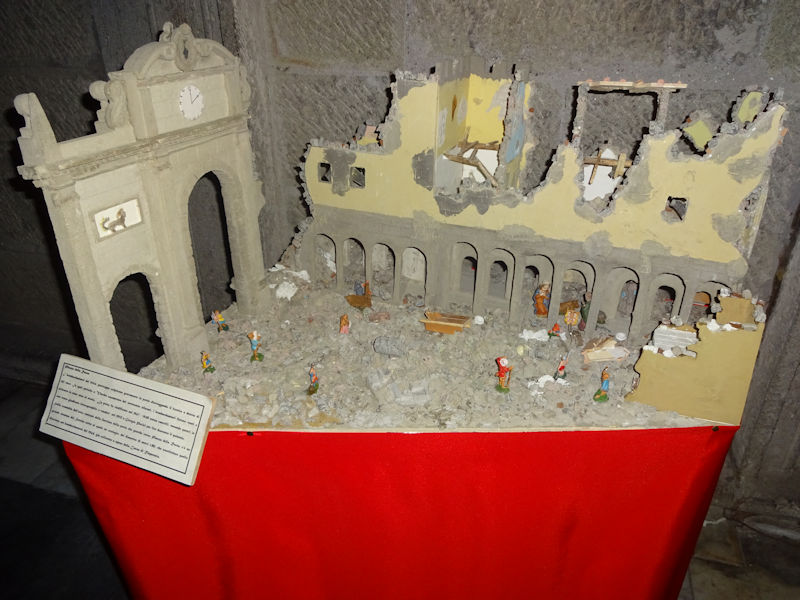
The Piazza della Rocca when the American bombers got through with it, May 1944
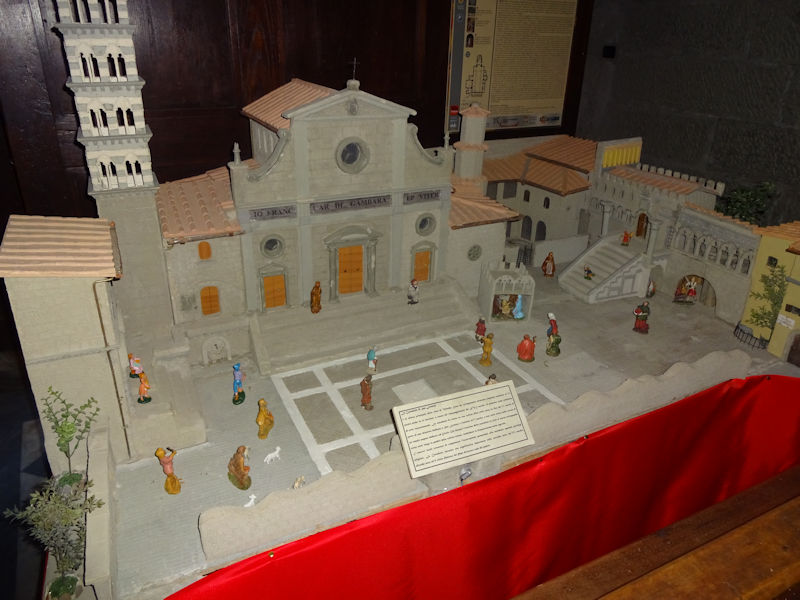
The Duomo and Papal Palace
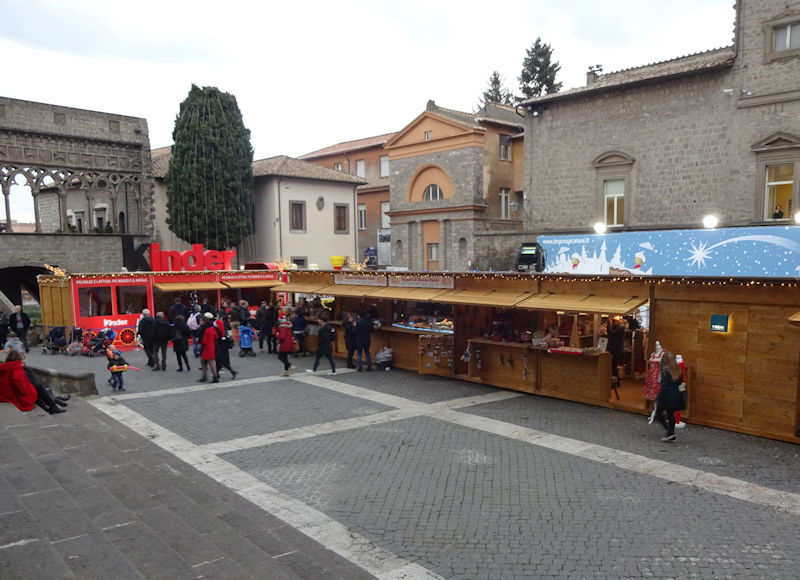
In the Piazza San Lorenzo in front of the Duomo
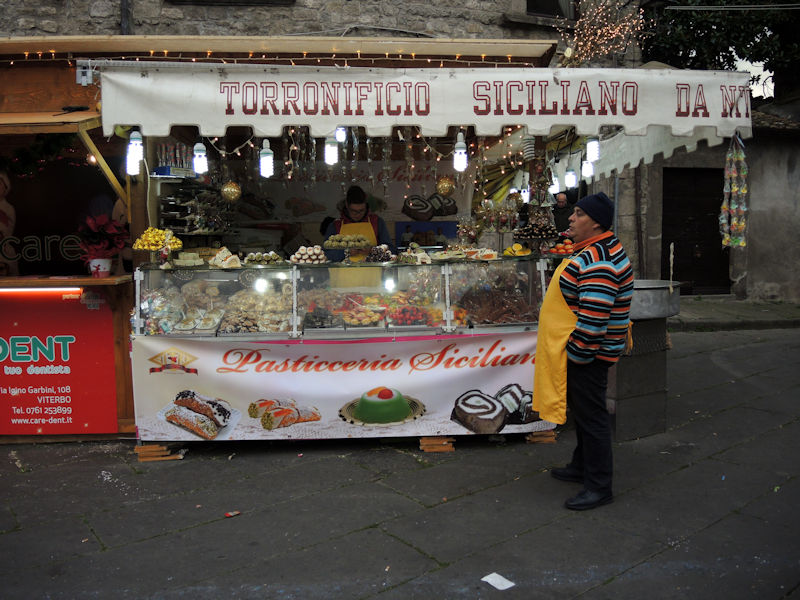
Sicilian nougat, ooof (photo by Juan Carlos)
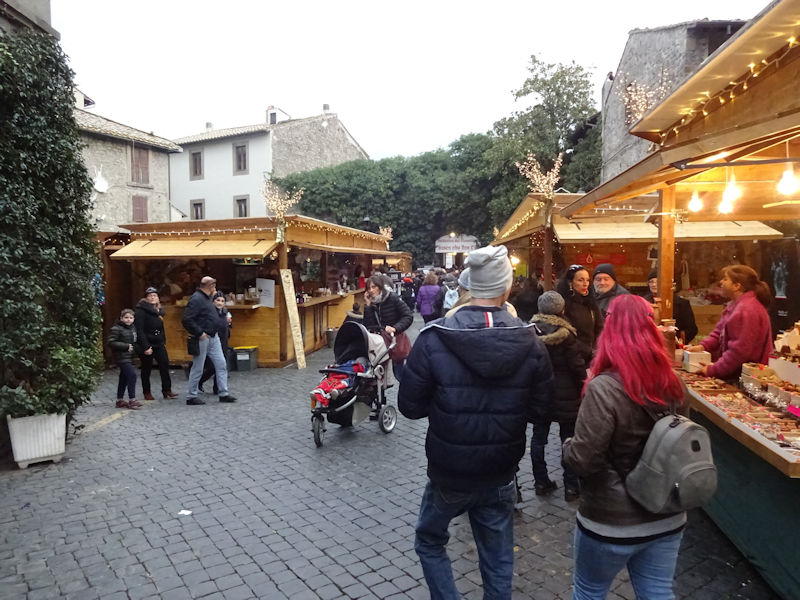
The Piazza di San Carluccio
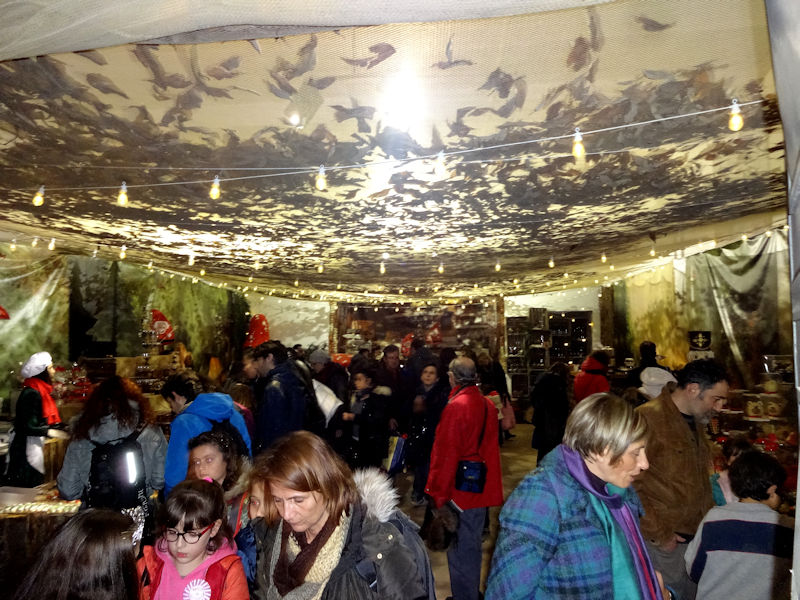
Juan Carlos lost in the House of Chocolate
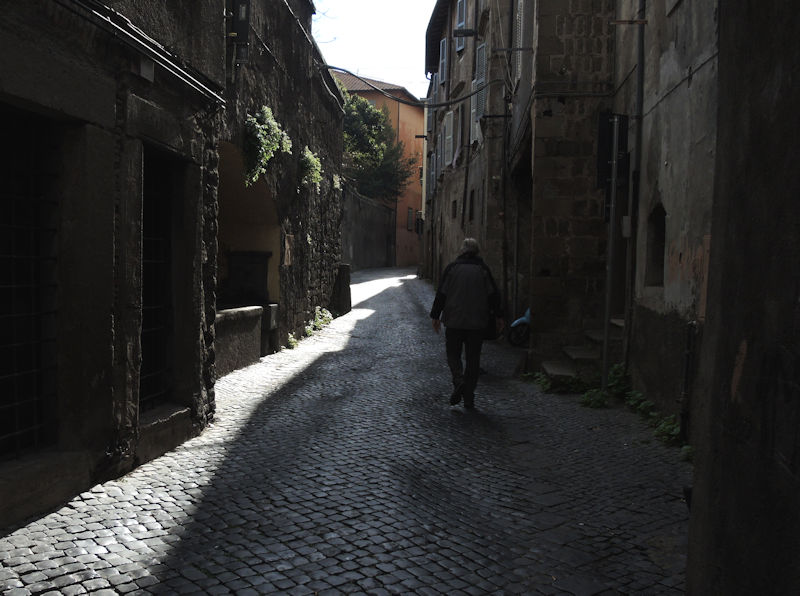
The dwellers in alleys (photo by Juan Carlos)

The Taverna del Gioco, fun, games, toys, and instruction in how to make your own
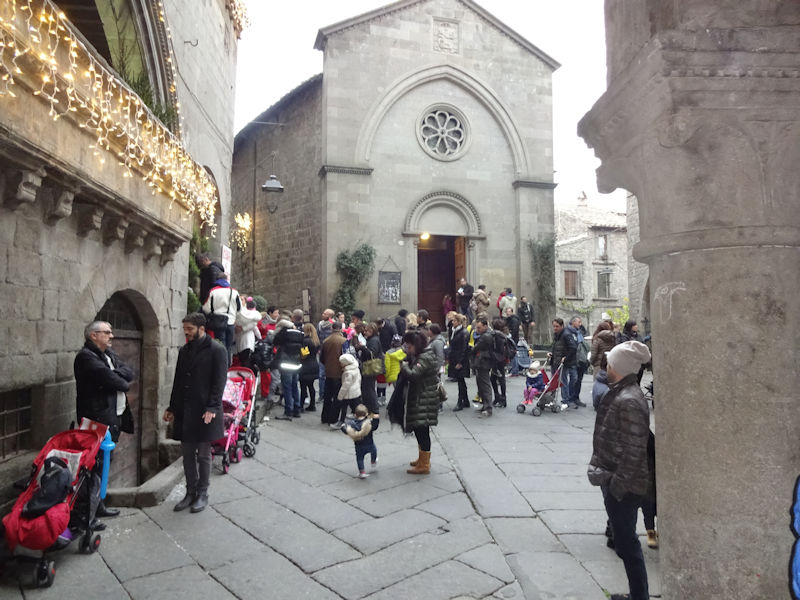
Back to the Piazza San Pellegrini, with a long line waiting to have a word with Santa

Long-suffering parents






































































































